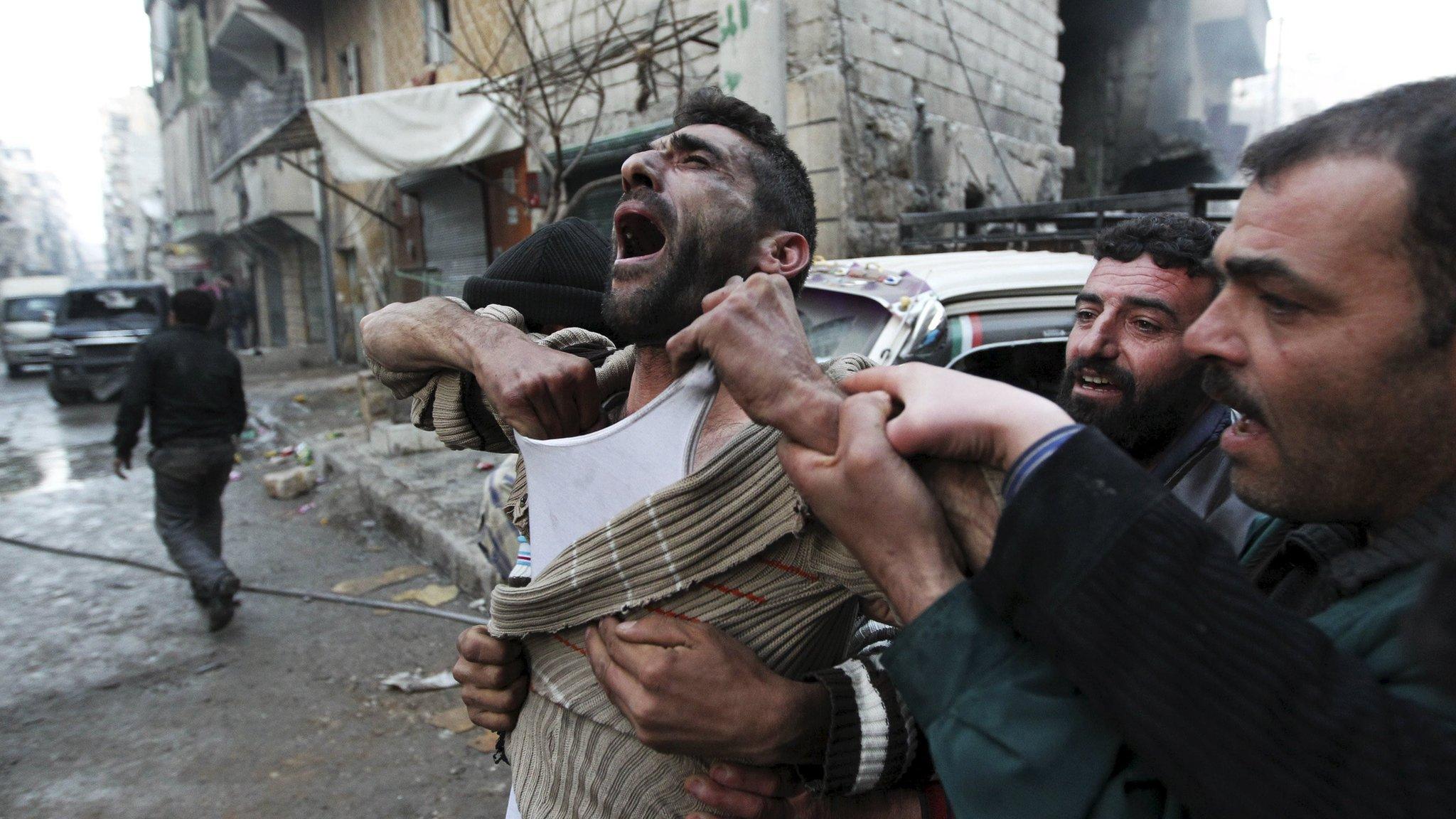Syria war: Weapons key players have at their disposal
- Published
Trump has said "nothing's off the table" - so what is on the table?
US President Donald Trump has told Russia to "get ready" for a missile strike on its ally Syria in response to a recent alleged chemical attack near Damascus.
Indications suggest that the type of strike being planned by Washington, with the possible assistance of the UK and France, will involve weapons launched from warships or submarines at long range.
Any aircraft used would be either firing weapons from beyond the reach of Syria's surface-to-air defence systems or be drones that can be remote-controlled.
Russian officials have warned that missiles will be shot down and their "launch sites" targeted.
But what weapons - that we know of - do the main players have at their disposal? And how might Russia and Syria respond?
US: Defence budget - $600bn
The US, whose guided-missile destroyer the USS Donald Cook is already in the Mediterranean, is likely to target chemical facilities in Syria with its cruise missiles.
Such action would avoid the risk of its fighter jets being downed.
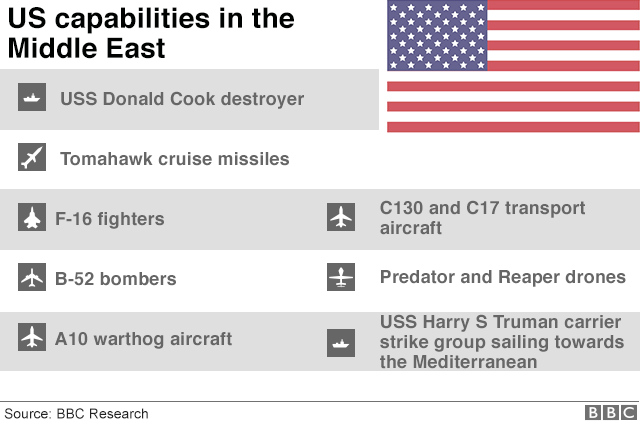
A year ago, two US Navy destroyers in the eastern Mediterranean Sea launched a total of 59 Tomahawk Land Attack Missiles (TLAMs) at the Shayrat airbase in Syria's Homs province.
Washington said the airbase was used to store chemical weapons used in a deadly attack on a rebel-held town just 72 hours before its military response.
The Tomahawks used have a small cross-section, fly at low altitudes and are very difficult to detect. They also emit little heat so they cannot be picked up by infrared detection.

The US Navy is also carrying a sizeable fleet of fighter jets on carriers in the Gulf, although it is unlikely to risk entering Syrian airspace immediately.
The largest US military base in the Middle East is in Qatar, where F-16 and A10 aircraft, also known as Warthogs, are located. These can be scrambled relatively quickly.
The F-16 has a reputation as one of the most reliable, manoeuvrable and effective military aircraft in the world. It has a range of about 2,000 miles (3,220km), which allows it to remain in combat zones longer than other aircraft.
The Americans also have long-range subsonic B-52 bombers, which they have deployed and used on targets in the region before.
In Kobane, a small Kurdish town at the Turkish border in northern Syria, the US has previously used an air base to deliver troops and equipment with C130 and C17 military transport aircraft.
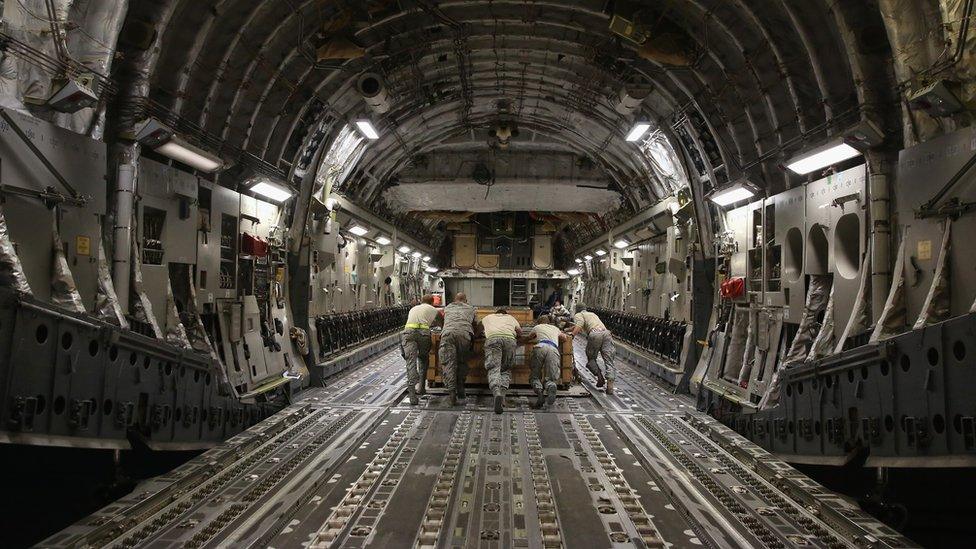
The cavernous interior of a US C17 transport aircraft
The vehicles are large enough to carry smaller aircraft such as helicopters and can be used to refuel combat jets in the air.
Russia: Defence budget - $69bn
The Russian threat to down any US attack has raised questions over whether their advanced, but as yet untested S-400 air defence system would come into play.
The multi-layered anti-aircraft system was deployed to the country after a Russian jet was downed there, and has so far only served as a deterrent.


It can fire three types of missiles and is said to be able to engage all aerial targets including aircraft and missiles within a 250-mile (400km) range with remarkable speed and efficiency - essentially providing a blanket of coverage for most of Syria.
Russia says the system has remarkable counter-stealth capabilities, warning in 2016 that "any illusions about 'invisible' jets will inevitably be crushed by disappointing reality",
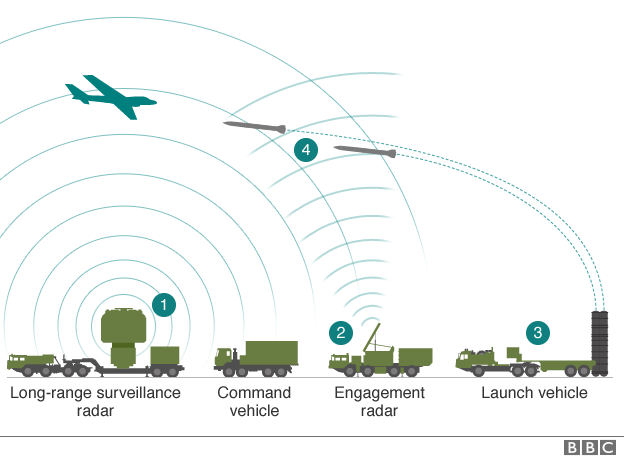
Steps 1- 4 show how the S-400 system's radar tracks objects, assesses potential threats and launches missiles to destroy the targets It can guide up to 12 missiles simultaneously, engaging up to six targets at once.
Dr Martin S Navias, from the Department of War studies at Kings College London, explains that the S-400 capability complicates usual traditional targeting tactics. Usually air strikes would aim to neutralise a country's surface-to-air capabilities but Russian anti-aircraft capabilities inside Syria would be an obstacle.
Its range stretches well outside Syrian airspace, which could mean targets being engaged before they ever reach Syrian territory. Some analysts have doubted the claims around the S-400's interception capabilities.
Russia also reportedly has several types of aircraft in Syria; Sukhoi-24 bombers, Sukhoi-25 warplanes, multi-role fighters, transport planes, spy planes and helicopter gunships.
Many of them are - or have been - stationed at Hmeimim air base, which is Russia's main base for air strikes on rebel groups.
The Russian military also reportedly began using Shayrat as a forward operating base for its Mi-24 and Mi-35 attack helicopters.

Russia is reported to have used Shayrat as a base for its Mil Mi-24 Hind helicopter gunships
From the Mediterranean, the Kremlin has said that it has previously used "Kalibr cruise missiles from the Rostov-on-Don submarine" to hit targets in Syria.
It has also fired rockets from warships in the Caspian Sea, which it said had struck IS targets in the country.
Meanwhile, Russia has withdrawn its battleships from its naval base in the Syrian port city of Tartus, according to recent reports.
UK: Defence budget - $50bn
The BBC's James Lansdale says the UK's Ministry of Defence (MoD) is poised and ready to deploy its resources in Syria.
These resources include a number combat aircraft based at RAF Akrotiri in Cyprus, which can be called upon for service at any time.
The British military has eight supersonic Tornados stationed at the base.
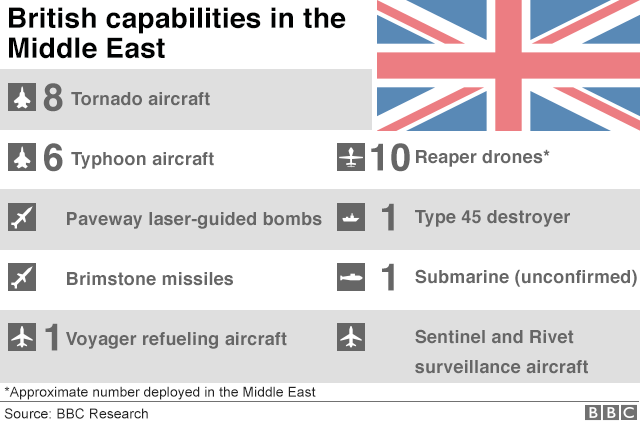
While somewhat aged - they were introduced into service in 1982 - the aircraft have more recently been equipped with precision-guided missiles.
RAF Typhoons have also been operating in the region and have carried out numerous strikes in Iraq in recent years. The aircraft use Paveway IV laser-guided bombs and Brimstone missiles to target strikes.
The Brimstone air-to-ground missiles are radar-guided, they weigh 49kg, are 1.8m long and thought to cost more than $142,000 (£100,000) apiece.
The RAF Tornado is flying into retirement next year
Britain has a fleet of unmanned aircraft in the Middle East, including about 10 Reaper drones, which have been used in missions over Iraq and Syria.
The RAF MQ-9 Reaper drone can fly as high as 50,000ft (15,240m) and has a range of 1,150 miles (1,850km). It carries "tank-busting" Hellfire missiles, according to the Royal Navy.
The UK's Rivet Joint surveillance aircraft, which can operate in any weather, are available and have already been utilised in US-led operations in Iraq.
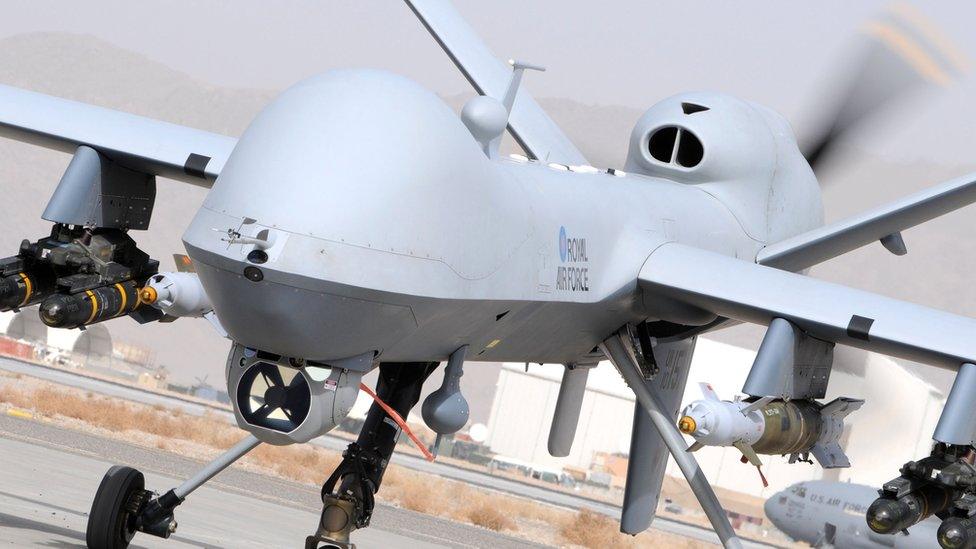
The MQ-9 is remotely controlled from the ground
The MoD says the planes are "highly inter-operable with the US", making them ideal for joint operations.
Britain, however, does not currently have a submarine in the Mediterranean and getting one into position could take days.
France: Defence budget - $42bn
The French Navy's nuclear-powered Charles de Gaulle aircraft carrier has previously been deployed for operations against the Islamic State group in the region, but is currently undergoing extensive refitting.
The 38,000-tonne ship - France's only such vessel - can carry an arsenal of missiles and bombs and a crew of more than 1,900 personnel.
For now, France has deployed sailors and aviators on board the US aircraft carrier USS George H.W. Bush for training and joint operations.

France's Charles de Gaulle aircraft carrier had been used for operations in Syria before
Separately, France has stationed several Mirage and Rafale fighter jets in Jordan and the United Arab Emirates, which it has used to target so-called Islamic State (IS) in Syria and Iraq. The jets can each carry four 250kg laser-guided bombs.
French President Emmanuel Macron has said any strikes on Syria in response to the latest alleged chemical attack would "not target allies of the [Syrian] regime or attack anyone, but rather attack the regime's chemical capabilities". Although he did not specify what measures would be taken.
Syria: Defence budget - $2bn (estimated)
Syria's air defence system has been heavily damaged by recent Israeli attacks, but it remains a threat to any aircraft as its missiles are still fast enough to strike them down.
The system used to be highly capable, consisting largely of missiles like the S-200, known to Nato by the codename SA-5 "Gammon". It has more recently been upgraded to include Russian weapons like the SA-22 and SA-17.
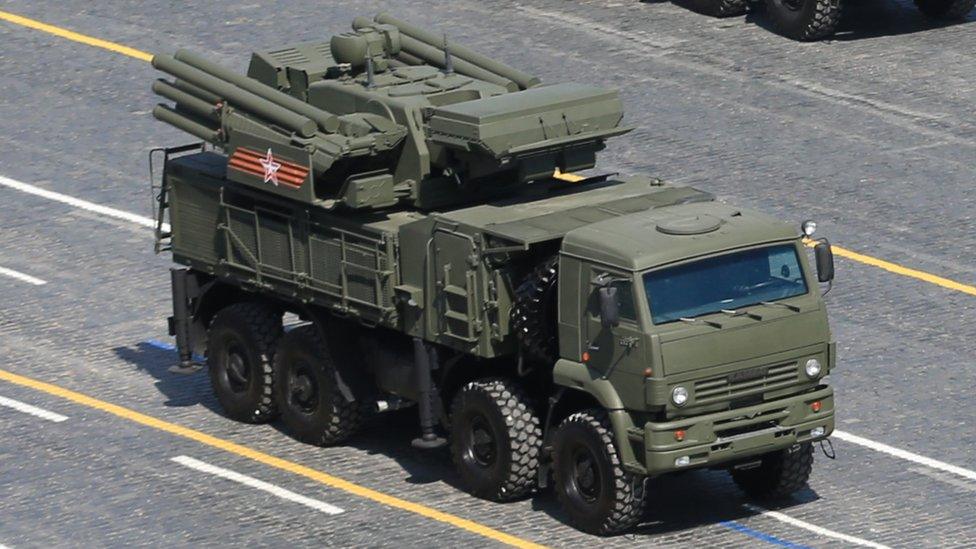
Syria has a number of Russian SA-22 surface-to-air missile weapons
The S-200 missile is liquid fuelled and designed to fly at speeds of up to Mach 8. It is guided to its target by radar, before detonating a 217kg (478lb) high-explosive warhead.
Syria also deploys a variety of sophisticated Chinese-supplied radar systems.
Meanwhile, the Shayrat airbase that was previously attacked by the US, has been occupied by the Syrian military throughout the country's civil war.
It has two 3km-long (2 mile) runways, as well as dozens of hangars, buildings and storage facilities. Syrian Air Force Su-22 and MiG-23 warplanes fly from there.
However, much of the fleet is old or obsolete and requires significant maintenance to remain militarily capable.
- Published10 April 2018

- Published11 April 2018

- Published10 July 2018
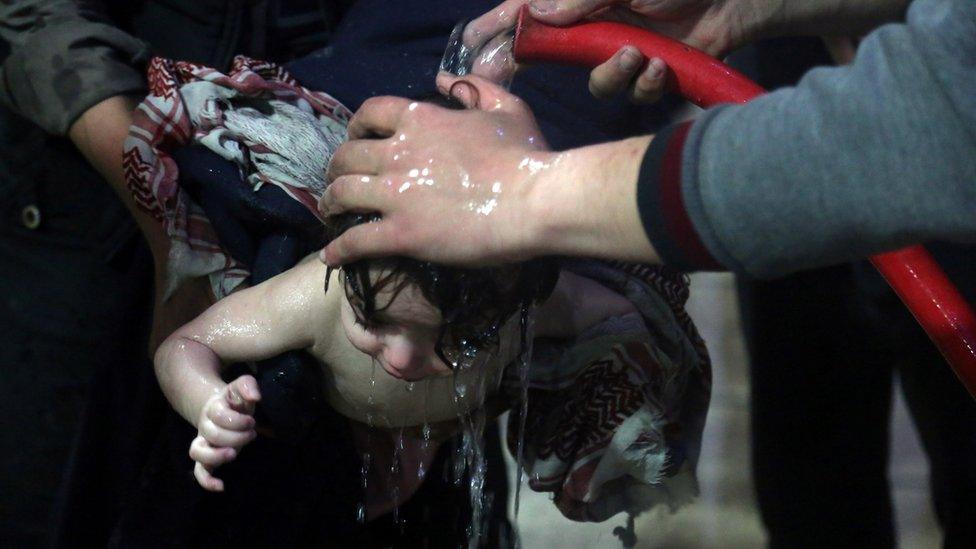
- Published2 May 2023
